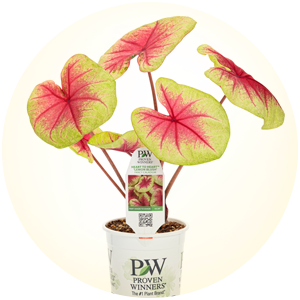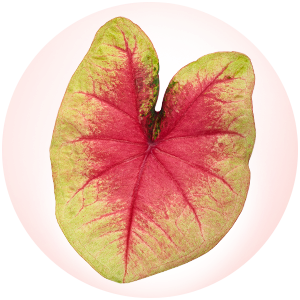Growing Caladiums from Sprouted Plants
If you live where the growing season is relatively short or want plants with instant impact, you may prefer to purchase your caladium as live plant in a container. This simply skips the step of needing to sprout the bulbs yourself, which can take as long as 6-8 weeks. Follow these tips for growing your sprouted caladium plants.

Choosing and Receiving Your Plants
POT SIZE: Sprouted caladium plants are sold in several different sized pots at garden centers. Generally, the larger the pot, the more bulbs it contains and/or the more mature the plants are. If your season is short or if you are looking for instant impact, choose the largest pot of caladiums you can afford.
TIMING: If your caladium plants arrive early in the season, open the box and allow them to breathe. Set the plants in a brightly lit space indoors where it is at least 65°F. Once the outdoor air temperatures are consistently at least 60°F and the soil temperature is at least 65°F, it is safe to plant your caladiums outside. If you move them outside too early, the cool temperatures will greatly slow down their growth and delay their flourishing in your garden.

Planting Your Sprouted Plants
SOIL: Caladiums grow beautifully in containers and in landscapes that have well-drained soil. Use a standard potting mix, like the one you use for growing annuals, when planting your caladium bulbs in containers. If you garden in heavy clay, you’ll want to grow your caladiums in containers or raised beds.
PLANTING DEPTH: Like all of your annuals, you will want to plant your sprouted caladium plants at the same depth they were growing in the container. They do not need to be planted any deeper.
SPACING: Caladiums generally grow 8-14” wide. If you are planting a mass of them and want them to grow together, space the plants about 8-10” apart. If you prefer to grow them as an accent plant among others in a garden bed, take care not to plant anything too aggressive next to them or they could get smothered early in the season before their growth spurt kicks in.

Caring for Your Caladiums
SUNLIGHT: All caladiums grow well in part shade (4-6 hours of sun). However, some varieties can tolerate full sun (6+ hours) in most parts of the country and others can tolerate full shade (<4 hours). The plant label will tell you how much sun the variety you select can handle.
WATERING: When you first plant your caladiums, keep the soil moist but not soggy. Keep an eye on those growing in full sun as they soil will dry out more quickly there. Once the plants are rooted in and flourishing in your garden, they will only need average amounts of water. Early morning is the best time to water caladiums.
HEAT: Caladiums are tropical plants that love the heat, even in southern climates. Their most active growth occurs during the warmest part of the season. That’s why it is important to wait to put them outside until the air temperatures are consistently at least 60°F and the soil temperature is at least 65°F. Caladiums can get stunted or may even stop growing completely if they are moved outside when it is too cool.
FEEDING: Caladiums don’t need as much fertilizer to stay happy compared to “hungry” flowers like petunias. When you plant them, mix some Proven Winners Premium continuous release plant food into the soil. Follow up with our water soluble plant food once per month.
PESTS: Caladiums are generally considered to be quite pest and disease resistant. Most problems that occur are the result of overwatering which can cause the bulbs to rot, too much sun or too much fertilizer. Though caladiums are considered to be moderately resistant to deer and rabbit browsing, they may nibble the foliage if there is no other suitable food source nearby.